MyDigitalSSD SMART & BP3 mSATA SSD Review
by Kristian Vättö on January 22, 2013 1:24 PM ESTAnandTech Storage Bench 2011
Last year we introduced our AnandTech Storage Bench, a suite of benchmarks that took traces of real OS/application usage and played them back in a repeatable manner. Anand assembled the traces out of frustration with the majority of what we have today in terms of SSD benchmarks.
Although the AnandTech Storage Bench tests did a good job of characterizing SSD performance, they weren't stressful enough. All of the tests performed less than 10GB of reads/writes and typically involved only 4GB of writes specifically. That's not even enough exceed the spare area on most SSDs. Most canned SSD benchmarks don't even come close to writing a single gigabyte of data, but that doesn't mean that simply writing 4GB is acceptable.
Originally we kept the benchmarks short enough that they wouldn't be a burden to run (~30 minutes) but long enough that they were representative of what a power user might do with their system. Later, however, we created what we refer to as the Mother of All SSD Benchmarks (MOASB). Rather than only writing 4GB of data to the drive, this benchmark writes 106.32GB. This represents the load you'd put on a drive after nearly two weeks of constant usage. And it takes a long time to run.
1) The MOASB, officially called AnandTech Storage Bench 2011—Heavy Workload, mainly focuses on the times when your I/O activity is the highest. There is a lot of downloading and application installing that happens during the course of this test. Our thinking was that it's during application installs, file copies, downloading, and multitasking with all of this that you can really notice performance differences between drives.
2) We tried to cover as many bases as possible with the software incorporated into this test. There's a lot of photo editing in Photoshop, HTML editing in Dreamweaver, web browsing, game playing/level loading (Starcraft II and WoW are both a part of the test), as well as general use stuff (application installing, virus scanning). We included a large amount of email downloading, document creation, and editing as well. To top it all off we even use Visual Studio 2008 to build Chromium during the test.
The test has 2,168,893 read operations and 1,783,447 write operations. The IO breakdown is as follows:
| AnandTech Storage Bench 2011—Heavy Workload IO Breakdown | ||||
| IO Size | % of Total | |||
| 4KB | 28% | |||
| 16KB | 10% | |||
| 32KB | 10% | |||
| 64KB | 4% | |||
Only 42% of all operations are sequential; the rest ranges from pseudo to fully random (with most falling in the pseudo-random category). Average queue depth is 4.625 IOs, with 59% of operations taking place in an IO queue of 1.
Many of you have asked for a better way to really characterize performance. Simply looking at IOPS doesn't really say much. As a result we're going to be presenting Storage Bench 2011 data in a slightly different way. We'll have performance represented as Average MB/s, with higher numbers being better. At the same time we'll be reporting how long the SSD was busy while running this test. These disk busy graphs will show you exactly how much time was shaved off by using a faster drive vs. a slower one during the course of this test. Finally, we will also break out performance into reads, writes, and combined. The reason we do this is to help balance out the fact that this test is unusually write intensive, which can often hide the benefits of a drive with good read performance.
There's also a new light workload for 2011. This is a far more reasonable, typical every day use case benchmark. It has lots of web browsing, photo editing (but with a greater focus on photo consumption), video playback, as well as some application installs and gaming. This test isn't nearly as write intensive as the MOASB but it's still multiple times more write intensive than what we were running last year.
We don't believe that these two benchmarks alone are enough to characterize the performance of a drive, but hopefully along with the rest of our tests they will help provide a better idea. The testbed for Storage Bench 2011 has changed as well. We're now using a Sandy Bridge platform with full 6Gbps support for these tests.
AnandTech Storage Bench 2011—Heavy Workload
We'll start out by looking at average data rate throughout our new heavy workload test:
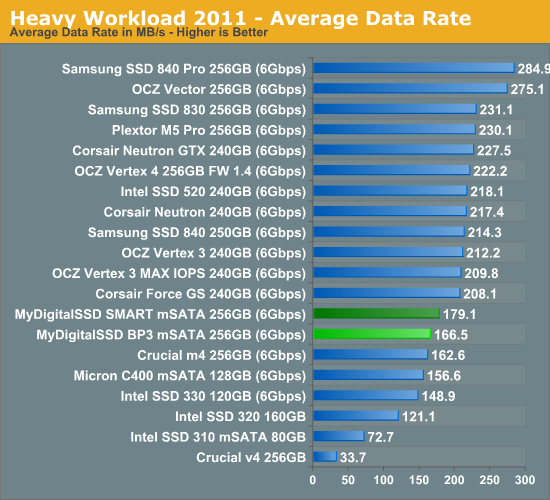
Despite the limitations of the PS3108 controller, the BP3 performs decently. The gap between it and the SandForce based SMART is only 12.6MB/s in our Heavy suite. Neither of the drives is able to keep up with standard 2.5" SSDs, but it's worthwhile to note that some of this is due to the limited NAND bandwidth (4 packages versus 8-16 in 2.5" SSDs).

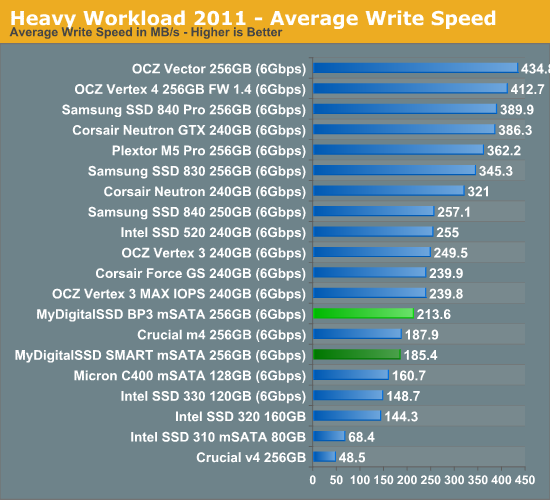
The next three charts just represent the same data, but in a different manner. Instead of looking at average data rate, we're looking at how long the disk was busy for during this entire test. Note that disk busy time excludes any and all idles, this is just how long the SSD was busy doing something:
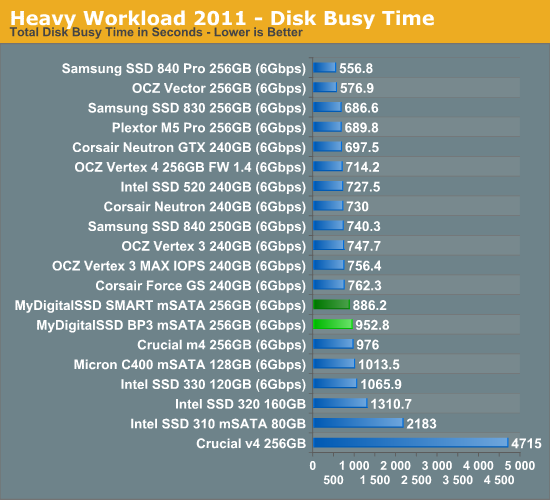
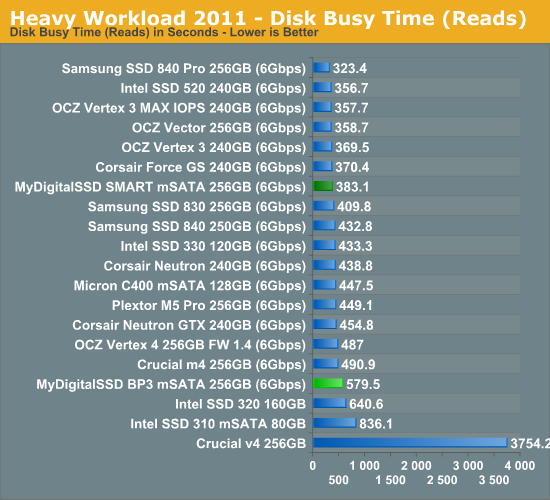
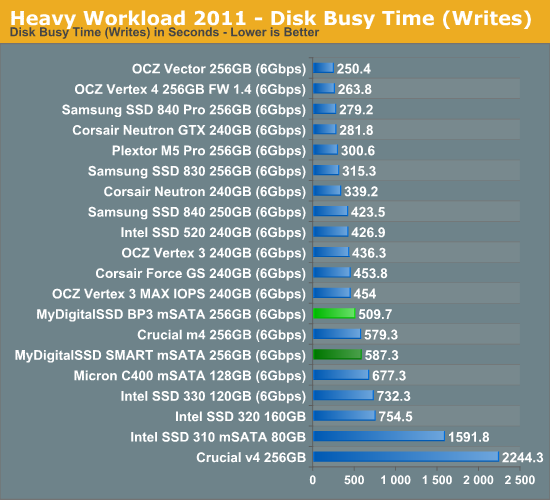










49 Comments
View All Comments
Chupk - Wednesday, January 23, 2013 - link
I love to read your reviews. And just want to give U thumbs up here knowing U R dealing with important exams at the same time while U R publishing high quality reviews.It's interesting to know U R stuck with word processing & HTML editing! >.<
I have long passed my days in University & I'm working as a Consultant in a Hospital. Just want to say the exams U R facing R kinda important. They should be your 1st priority at least for the moment!
Stranman - Wednesday, January 23, 2013 - link
It would be nice to see a comparison or charts of mSata only drives (apples to apples), not apples and oranges. If I'm looking for a mSata drive, I don't care to see standard 2.5" SSD drives listed.Kristian Vättö - Wednesday, January 23, 2013 - link
I thought about that at first but the problem is that we have only reviewed two mSATA SSDs on top of these MyDigitalSSD ones. I do have a couple more in the lab now, so stay tuned for more mSATA stuff. I think it's also worthwhile to compare them to similar SATA 2.5" drives because there is a performance difference and some might go with the 2.5" because of that.Sp4rrowhawk - Wednesday, January 23, 2013 - link
I'm a big thinkpad fan. And while my T410 doesn't have an mSata bay, both the T420 and T430 do.Also I own a home server and have a dedicated system drive. My (new) motherboard has 8 Sata ports or 7 plus 1 mSata port. As such I can't add one more drive but I can save up a 3.5" bay that would otherwise be used by my system drive. So I'm planning on buying one for that use-case. Obviously I don't need 256GB for my system drive though...
ChristopherD - Wednesday, January 23, 2013 - link
Being a traveling photographer, speed and portability is always crucial.mSATA SSD form factor coupled with an external thunderbolt chassis would be a great combo that I would purchase myself. When I have only 30mins to edit and backup a 100GB folder of photos/videos and leave a site an external SSD this small would be great.
Sottilde - Friday, January 25, 2013 - link
It seems that the M4's performance is (surprisingly) just a bit worse than the BP3's, and the M4 mSATA is just a bit more expensive. However, I'm doubtful of the longevity of Toggle-mode MLC; the last review I read on it said that it was guaranteed for only 1000 cycles. In addition this brand has a bit of a dubious name.Given those facts, which mSATA drive would you all choose?
JeBarr - Friday, January 25, 2013 - link
A full size ATX desktop board or even some mATX board users could make use of mSATA PCI-E x1, x4 or x8 with 1, 2, 3 or 4 drives in "raid". These add-on cards already exist but the price is out of reach for most outside of enterprise.I'd much rather swap out a dead mSATA drive rather than purchase another Revo drive that slowly dies.
SSDuser101 - Tuesday, February 12, 2013 - link
MyDigitalSSD has been around a while now. Since 2007 when they introduced the 1st upgrades for netbooks like the Asus 901 Mini PCI-e SSD.They have been selling mSATA SSD longer than anyone with nothing but great reviews.
Also regarding Sottidle’s post about Toshiba toggle nand. He must be thinking of TLC Triple Layer Cell Flash like what ships on the Samsung 840 drives because those do have around a 1K Cycle life span. On the contrary Toshiba Toggle NAND is the best on the market when it comes to MLC flash with a 5K R/W/E cycle minimum.
systemBuilder - Saturday, June 27, 2015 - link
Since 99% of all macbooks are shipped with a disk drive that is too small, because of Apple's horrific pricing policies, well yes, there is a huge market for mSATA drives, but only for macbooks from 2014 and earlier. The new 2015 macbooks have new PCIe drives that run 3x faster, but are not compatible with mSATA.